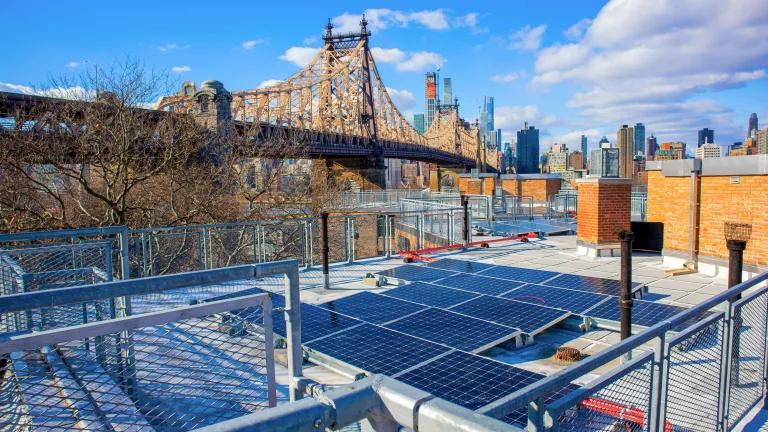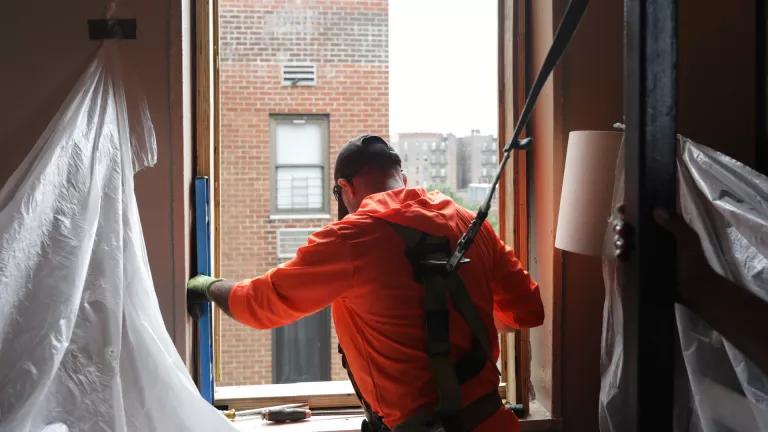Will New York Squander Its Opportunity for a Just Transition?
New York’s clean energy transition is threatened by state laws that perpetuate, promote, and subsidize fossil gas use.

A section of rooftop solar panel arrays installed across the New York City Housing Authority's Queensbridge Houses
Courtesy of NYCHA
New York’s clean energy transition is threatened by state laws that perpetuate, promote, and subsidize fossil gas use.
The state legislature must amend these laws by passing the New York Home Energy Affordable Transition (NY HEAT) Act this session to avoid wasting billions on new fossil gas infrastructure. Failing to do so will result in a disorderly transition for gas utilities and workers, as well as skyrocketing bills that disproportionately burden vulnerable utility customers.
Achieving New York’s climate targets requires dramatic reductions in gas use and the strategic downsizing of the utility gas system
New York’s nation-leading Climate Leadership and Community Protection Act (Climate Act) sets forth ambitious, economy-wide climate and clean energy targets that require all sectors of the state’s economy to collectively transition to net-zero emissions by 2050. The Climate Act also includes important provisions for climate justice that prioritize equity in fighting climate change to ensure that disadvantaged communities are not left behind in New York’s clean energy transition.
According to the Climate Action Council Scoping Plan—the blueprint for achieving the Climate Act goals developed by representative stakeholders and government officials over the last three years—there will need to be a major reduction of fossil gas use, especially in the buildings and electric sectors, and a transition of the vast majority of gas utility customers to electricity for heating and hot water.

U.S. Energy Information Administration, New York State Energy Profile
Because both the amount of gas sold and the number of gas customers need to dramatically decrease to achieve the Climate Act targets, the Scoping Plan’s Gas System Transition chapter calls for a well-planned, strategic downsizing of the gas system that takes place as quickly as possible and to the greatest extent possible. This will maximize environmental benefits and minimize “stranded costs” of the legacy gas system that would likely be paid for by ratepayers and taxpayers long after the gas infrastructure is no longer in use.
Importantly, the strategic transition of the gas system needs to start as soon as possible to manage the long-term cost, affordability, and equity impacts because the more gas infrastructure we build or replace today, the more expensive the gas transition will be.
The Scoping Plan calls for legislative action to enable a strategic transition of the gas system
The well-planned and strategic downsizing of the gas system recommended by the Scoping Plan is impossible under current law because existing provisions in the Public Service Law governing the regulation of utility gas service perpetuate, promote, and subsidize the expansion of the gas system.
As the Scoping Plan identifies, the Public Service Commission (PSC) initiated utility-specific gas system planning processes and a statewide GHG emission reduction pathway study to develop long-term plans for the transition of the gas system. However, the PSC has limited authority to implement a downsizing of this system because certain provisions of Public Service Law conflict with this goal and the achievement of the Climate Act’s targets.
In particular:
- the 100-foot rule in Public Service Law section 31(4) requires existing gas ratepayers to subsidize building new gas infrastructure to hook up new customers; and,
- the utility obligation to provide gas service in Public Service Law sections 30 and 31 establishes a customer’s entitlement to gas service and thereby enables a single customer to block community-scale projects that would facilitate cost-saving downsizing of the gas system.
These provisions provide clear examples of why New York is a case study for the need to harmonize states’ energy utility regulation frameworks and climate laws. Without amending the provisions of the Public Service Law that conflict with the Climate Act, the PSC’s gas system planning processes will lead to further expansion of the gas system instead of the strategic downsizing recommended by the Climate Action Council.
The Scoping Plan thus calls on the legislature to “review and consider modifications to statutory provisions that may seem to be in conflict with the requirements of the Climate Act” and “bring them into alignment with the Climate Act to ensure that regulators and utilities do not have conflicting directives from the legislature and have the clear authority required to take action.”
Utility investments in new gas infrastructure jeopardize an equitable, affordable, and orderly transition of the gas system
The need to address these statutory tensions is urgent, as utility-specific gas system planning processes have already begun, and gas utilities are continuing to rapidly invest billions to fortify and expand their fossil gas systems—potentially squandering our best opportunities for strategic, cost-saving downsizing.
Over the last five years, existing gas customers have spent $1 billion subsidizing the expansion of the gas system due to the 100-foot rule.
Gas utilities are also currently planning to replace more than 7,000 miles of leak-prone pipe with brand-new pipe and to replace nearly 190,000 leak-prone service connections over the next 20 years. According to Synapse Energy Economics, this new gas infrastructure will cost customers $150 billion, with more than half of this cost hitting bills after 2050 when the replaced pipe will likely be a stranded asset (see graphic below).
The NY HEAT Act harmonizes New York’s gas and electric utility regulation framework with the Climate Act

New York’s legislature can address the urgent need to remove the statutory barriers jeopardizing an equitable, affordable, and orderly transition of the gas system by passing this session the NY HEAT Act, which is fully aligned with the Scoping Plan and necessary to implement the Climate Action Council’s vision for a well-planned downsizing of the gas system that enables achievement of the Climate Act’s targets.
Passing the NY HEAT Act this session is critical, as it:
- Empowers the PSC to equitably achieve the Climate Act’s climate justice and emission reduction targets and makes doing so an express regulatory objective;
- Amends both the gas utility obligation to serve and the 100-foot rule subsidy for expanding the gas system, thereby removing statutory conflicts with the Climate Act;
- Facilitates a well-planned and strategic downsizing of the gas system by enabling community-scale solutions that facilitate the downsizing of gas infrastructure over time; and,
- Establishes several new requirements that will protect vulnerable customers from disproportionately bearing the cost of a disorderly transition to clean energy, including that no one pays more than 6 percent of their income for their energy bills.
Enacting the NY HEAT Act this session will enable the state and gas utilities to make the most of the gas system planning processes that are just getting underway and, ultimately, pursue a strategic downsizing of the gas system that will manage costs; prioritize affordability; protect vulnerable customers; facilitate a just transition for workers; provide certainty for utilities; and create safe, comfortable, climate-friendly homes for New Yorkers over the coming decades.
This blog provides general information, not legal advice. If you need legal help, please consult a lawyer in your state.



